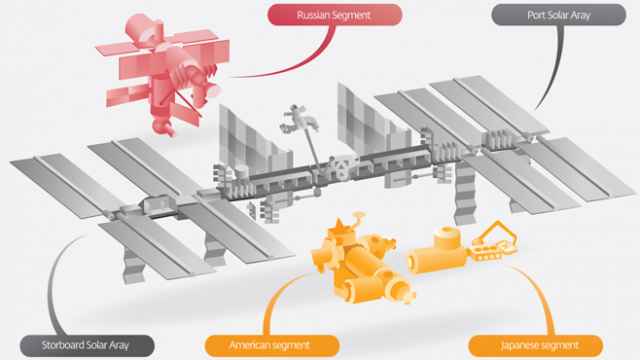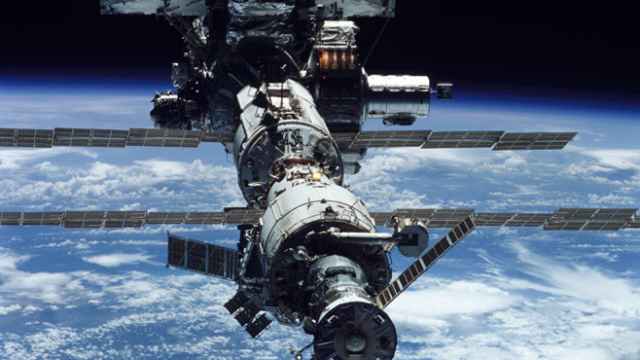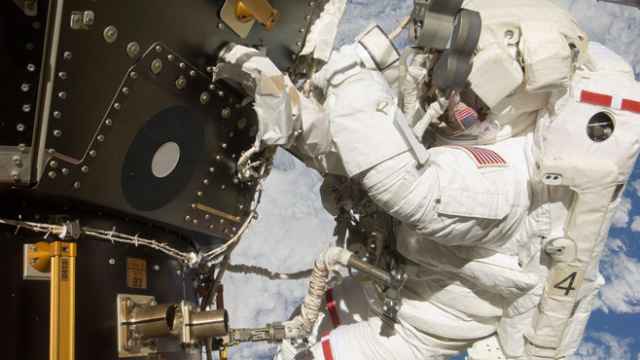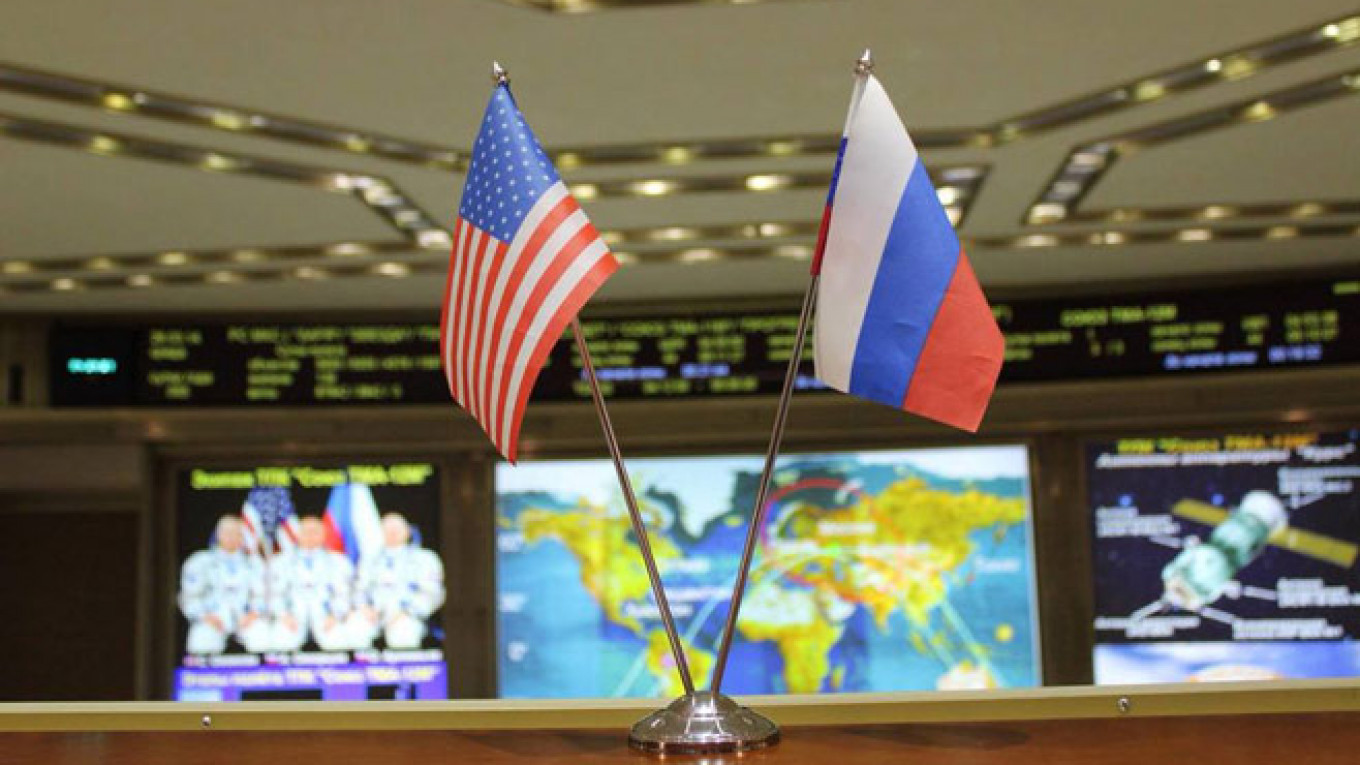In the summer of 2000, a Soviet-designed Proton rocket was rolled out to its launch pad at Site 81 of the Baikonur Cosmodrome, a former military black site hidden on the sprawling steppes of Kazakhstan from which the Soviet Union embarked on its conquest of space in the late 1950s.
Rockets like this one, and a myriad of others designed by legends of the Soviet military-industrial complex, had illuminated the Kazakh desert for decades — propelling amazing feats of Soviet engineering into space under the crimson banner of international communism.
But times had changed. The space race was over.
All In It Together?
NASA and Roscosmos exchange personnel, ensuring that their respective mission control centers have the human and technological resources available to smoothly handle daily operations as well as the occasional problem — sometimes things go very wrong.
When emergencies arise, it is the job of Keith Zimmerman and his NASA colleagues rotating in and out of Russia's Mission Control Center, to help facilitate communication and coordinate responses from the U.S. and Russian sides.
“In the event that problems occur, it helps to have someone locally to explain what the problem is and what we're doing about it, and here's what you [Roscosmos] can do to help. And that's why the Russians have a team in Houston as well,” he said.
One such emergency — one of the more dramatic in the history of the U.S.-Russia space partnership — took place in June 1997, when the Mir space station was hit hard by a Russian resupply spacecraft with two Russian cosmonauts and one NASA astronaut aboard.
The collision punched a hole in the space station's hull, destroying a solar panel. As air hissed out into the void, the station's crew felt their ears popping as a result of the rapidly falling air pressure, and the station itself was sent into a dramatic spin.
Mission control was unaware that anything had gone awry, as the station was beyond the range of Russia's communications coverage — which at that time was limited to a period of 5-10 minutes every 90 minutes.
Zimmerman had been preparing to touch base with the NASA astronaut, Michael Foale, before attending meetings with a senior Russian official, so he had his interpreter in tow. As Mir came into range, the control center was flooded with the sounds of alarms — never a good sign.
“The Russians were talking so fast that I couldn't catch any of it,” Zimmerman said. “My interpreter just had this funny look on his face, and said 'uhhh, they hit something.' It was a very crazy 10 minute communication pass while they were trying to find the leak, seal it, and save the station.”
The crew struggled to seal the hatch. The doorway was blocked by a series of electrical cables, feeding power to the station from the solar panels attached to the damaged module. These cables would need to be cut before the hatch could be closed, but this would kill Mir's power.
“At the end of the communications pass, they were just starting to seal the hatch, and before they did that the comms pass ended,” Zimmerman said. No one was sure if the crew was dead, if they abandoned ship, or sealed the hatch and saved Mir.
The crew saved the station, and managed to close the hatch. Meanwhile, NASA increased communications with Mir — thus allowing Roscosmos to work faster to help the crew in space — by activating three ground stations across the world, crucial assets that Russia had lost with the fall of the U.S.S.R.
“This was Mir, and it was their ship, so it was their responsibility to figure out what had gone wrong and what the problem was, and we helped out where we could by providing extra communications assets. Our sites were in the gaps where theirs weren't, so we gave them more opportunities to talk to the crew,” Zimmerman recounted.
The 1997 Mir incident was perhaps the most dramatic in the history of the partnership. But space exploration is a series of inevitable pitfalls, and collaborative problem-solving has been necessary throughout the course of the ISS program. When the U.S. space shuttle Columbia disintegrated upon reentry in 2003 — killing the seven NASA astronauts aboard — Roscosmos helped NASA send people and supplies to ISS via its Soyuz spacecraft.
And NASA has returned the favor when things go wrong on Russian missions, allowing cargo to be ferried up on U.S. vehicles if need be, and always assisting with its expansive communications system — something Russia lacks to this day. When a construction worker severed a cable connecting Russia's mission control to its satellite dishes in 2012, causing Roscosmos to lose control of very single satellite and spacecraft it had in space, their ability to use U.S. communications was crucial.
The Proton rocket set to launch that summer was plastered with a large logo advertising the American fast-food giant Pizza Hut, which helped finance the mission.
Its cargo was Zvezda, a space module in which Russian cosmonauts and American astronauts could cohabit while orbiting Earth.
Zvezda was the third piece of the International Space Station (ISS), a massive facility in space designed and constructed by NASA and its Russian counterpart, Roscosmos, and its long-awaited launch allowed the station to be officially opened for business.
Fifteen years later, ISS has the distinction of being the largest ever collaboration between nations during peacetime — a feat that earned a Nobel Peace Prize nomination.
The cost of the ISS project had been valued at up to $150 billion, and today is a partnership of 16 nations operating under the umbrella of NASA and Roscosmos — making the station one of the final frontiers of U.S.-Russian relations following almost two years of political animosity.
Sean Fuller, NASA's top official coordinating work with Roscosmos, said the ISS program's significance in U.S.-Russia relations has been its ability to draw on different approaches and experiences to find the best common path to overcome various concrete challenges.
“The strength of the program is that all of the partners have previous experiences and expertise in different areas, and while the United States and Russia have very strong histories of spaceflight, we tackle problems differently,” explained Fuller.
U.S.-Russia Cooperation in Space: A Brief History
In 1957, the Soviet Union launched Sputnik, the world's first artificial satellite, kicking off the famous Cold War space race that continued until the mid-1970s. After the United States beat the Soviets to the moon, the U.S.S.R. shifted their focus to building space stations.
As part of the policy of detente pioneered by U.S. President Richard Nixon and Soviet leader Leonid Brezhnev, the two sides decided to use their space programs as the symbol of a new era in their tepid bilateral relations.
The product of this effort was the 1975 Apollo-Soyuz Test Project, a rendezvous between a U.S. Apollo spacecraft and a Soviet Soyuz capsule above the Elbe River in Germany. It showed what was possible, but was a one-off. Superpower tensions flared not long after and the space programs again went their separate ways.
Twenty years later, after the fall of the Soviet Union, senior leadership on both sides saw an opportunity to use their space programs as tools of reconciliation and cooperation rather than of political competition.
This was pursued in two phases. Phase One, launched under a protocol signed at the 1993 summit between U.S. Vice President Al Gore and Russian Prime Minister Viktor Chernomyrdin, initiated a program known as the Shuttle-Mir missions.
Over the course of the decade, NASA would fly 11 space shuttle missions to dock with the Soviet-built Mir space station so that the U.S. space agency could gain vital experience in long-duration stays in space.
Shuttle-Mir was an important step towards the larger vision of the Gore-Chernomyrdin agreement, known as Phase Two: the construction of a massive international space station, adapted from plans for Russia's proposed Mir 2 space station and the U.S. Space Station Freedom, both projects that were stalled in the 1990s amid post-Cold War budget cuts.
Snapshot of a Partnership
NASA's Fuller joined the U.S. space agency out of college in 1996, and has made a career of working with the Russians following his first visit to Moscow in 1997 as a NASA space shuttle mission planner.
“It was a new experience,” he said, “I still remember that first time I walked onto Red Square thinking 'by golly, I never thought I'd be here.'” Over the last two decades, Fuller has worked at various levels of the partnership, fostering deep relationships with his Russian counterparts.
Fuller describes his bonding with Russian space officials in a similar way to other NASA officials who have been living, working, or traveling to Russia since the mid-1990s: things were awkward at first, but people quickly warmed up to each other.
For Fuller, it began in 1997 at a picnic with a few Roscosmos officials in Alexandrovsky Sad outside the Kremlin. “We really got to know each other on the personal level, about lives and families … it really created a good bond that continues to this day.”

A Diagram of the International Space Station in Its completed form
Since those early meetings, Fuller has made his way to the top of NASA's organizational structure in Moscow, surviving marathon meetings with Roscosmos officials that concluded with feasts and toasts proposed to cooperation in space — an experience Fuller described soberly as “a bit different … operating.”
Today he presides over a permanent NASA contingent of no fewer than 30 employees spread between three Roscosmos facilities in Moscow's surrounding region — the U.S. agency even rents an entire floor of a Moscow hotel to house its personnel.
Fuller manages everything from his small office in Roscosmos headquarters at Prospekt Mira. There he coordinates regularly with senior Roscosmos leadership, and even works with Russian space companies like RSC Energia and the Khrunichev Space Center.
But most of the action happens at Russia's Mission Control Center in Korolyov, a town just outside Moscow named after the Soviet Union's most esteemed rocket designer — Sergei Korolyov.
“Our job specifically is to be there working with their flight control team,” said Keith Zimmerman, a NASA flight controller who has rotated in and out of Russia's mission control center for 20 years.
Teams of four rotate the day and night shifts so that NASA has people in Russian mission control at all times to ensure communication with flight controllers in Houston.
While groups of Russian and U.S. flight controllers working on certain parts of the ISS talk to each other regularly, Zimmerman's team is there to facilitate communication between groups that work together less frequently, and — of course — coordinate responses to emergency situations.

The International Space Station under construction in 2002. This photo shows the station after the addition of its 11th part, a truss to begin expanding the station. At this point, ISS was already larger than its Mir predecessor.
Getting to Know One Another
Establishing this relationship took time. During the Shuttle-Mir program, the Russian side had to overcome a deep suspicion of U.S. scientists stealing secrets, concerns stoked by nosey NASA engineers asking too many questions about how Mir worked.
“We started asking questions about their space station systems because we didn't have any space station of our own yet, and we were still working on building one,” said Zimmerman
“They thought that we might be trying to steal their ideas and technology to design our own station,” Zimmerman said, though they eventually understood the intent was to ensure the shuttles could work with Mir systems, and this required a basic understanding of how the station worked.
Beyond trust issues, there were cultural differences that had to be understood and bridged — a problem that NASA officials in Russia say most often got in the way during planning for missions.
“With spaceflight, a lot of it is driven by hard physics, so a lot of the technical stuff is pretty well defined by physics, and it really comes down to how you operate and plan it within those rules,” Zimmerman explained.
This is where approaches differed, a product of the kinds of missions the two space agencies had been planning and executing in the final decade of the Cold War.
NASA in the 1970s developed space shuttles in anticipation of building a large space station, but the funding never materialized. The Soviets jumped straight into space station design, mastering the art, but never succeeded in fielding its own copy of the U.S. shuttle to service them.
Therefore, NASA planning was geared toward making the most of the shuttle's two-week flight times, with plans constantly being optimized and revised over the 18 months leading into a launch, and then daily during a mission.
The Russians were approaching the operation of their Mir space station in a completely different manner, leading to some frustration when the two sides came together to plan missions in which the space shuttle would visit Mir.

NASA astronaut Mike Hopkins conducting the second of two spacewalks over a four day period in December 2013 to replace a faulty water pump on the exterior of the International Space Station.
“On the shuttle we were very detailed, every minute was laid out, because there was limited time,” Fuller explained. “But we learned pretty quickly that its okay to operate that way for a week or two, but it you're living in space for six months, that's going to get old real quick.”
Likewise, Fuller said that in the beginning, the way plans were drafted caused friction. While NASA was making plans on computer software that allowed changes to be made quickly and effortlessly, Roscosmos was adamantly opposed to most changes.
Their opposition was largely based on how Roscosmos drafted plans — on a giant scroll drawn out box-by-box by a man and a drafting board. To make a simple change required the entire scroll to be remade.
“So we learned a lot of that from the Russian [space] culture, but then likewise as we moved on to ISS we developed a next-generation computer planning tool, and they were brought in to that [program] so we had a kind of melding of the two approaches for ISS,” he said.
According to Fuller, this ability to merge strengths and approaches to spaceflight is the essence of the ISS program's success. As problems were ironed out, they were left with a better approach to sending people to space.
In terms of co-managing a station, NASA officials say that today they do not encounter major problems with their Russian colleagues, though sometimes disagreements happen — be it over fixes to common problems, launch schedules for Russian or U.S. rockets, and so on.
“I think we are definitely the more flexible ones,” Zimmerman said. “If there are a couple of options to address the problem, and the Russians are just absolutely insisting that it has to be this or that for whatever reason, we will — more often than not — agree to their option.”
These problems are minor, and the growing pains of Shuttle-Mir feel far away. For 15 years, ISS has been successfully co-managed by Russia and the United States, and has grown to become a massive 1 million pound structure in orbit.
Though U.S.-Russia relations turned turbulent in 2014, the two sides agreed this year to extend the ISS program until at least 2024 — four years beyond its original planned conclusion. Observers on both sides doubted this was possible in the current political climate.
As Fuller acknowledged, “as things in the world have changed, there [remains] certainly a strong interest in both governments — actually in all of the governments involved — and ISS has shown what we can achieve together.”
Contact the author at m.bodner@imedia.ru
A Message from The Moscow Times:
Dear readers,
We are facing unprecedented challenges. Russia's Prosecutor General's Office has designated The Moscow Times as an "undesirable" organization, criminalizing our work and putting our staff at risk of prosecution. This follows our earlier unjust labeling as a "foreign agent."
These actions are direct attempts to silence independent journalism in Russia. The authorities claim our work "discredits the decisions of the Russian leadership." We see things differently: we strive to provide accurate, unbiased reporting on Russia.
We, the journalists of The Moscow Times, refuse to be silenced. But to continue our work, we need your help.
Your support, no matter how small, makes a world of difference. If you can, please support us monthly starting from just $2. It's quick to set up, and every contribution makes a significant impact.
By supporting The Moscow Times, you're defending open, independent journalism in the face of repression. Thank you for standing with us.
Remind me later.


